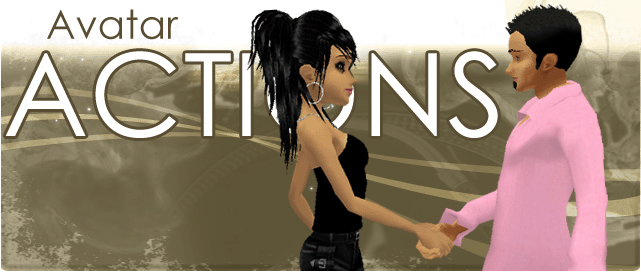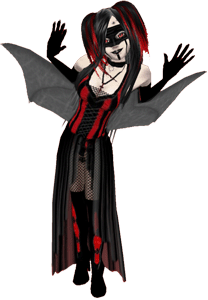
Introduction
Animations and sounds add life to all environments including IMVU and Actions are the tool Creators use to piece those animations and sounds together in an IMVU product.

What is an Action?
An Action is a collection of animation and/or sound assets that play back in IMVU. Actions follow several hard coded rules but, in essence, can be as simple or complex as you like. Actions also afford you the incedible ability to create random playback events and, therefore, add a feeling of life to all of your products.
Adding Actions is well worth the effort as those product that contain Actions (and chickens, mustn’t forget chickens) sell very well with the IMVU audience.
The IMVU Action System
What Products Contain Actions?
Every base 3D product type can include Actions. This includes Avatars, Avatar clothing, Avatar Accessories, Modicons, Furniture and Rooms. Even more, Room and Furniture products can contain Actions that effect the Avatar as well.
NOTE: Although Eye and Skin products are, by definition, Avatar clothing products, they can not contain Actions (as far as we know) as they do not override body part IDs and therefore do not have a way to influence the Avatar.
Action Types
There are three types of Action:
- Idle Actions
- Stance Actions
- Triggered Actions
An Idle Action plays forever and does not require input from a person in order to do so.
A stance Action is dictated by a room or furniture seat node. For example, if a seat node is named seat01.FloatinInWater, then the IMVU code wants to play an animation called stance.FloatingInWater. If an Action with the same name exists in either the avatar product or within the Room or Furniture product, that animation will be applied to the Avatar. The three main Idle/Stance Actions names are stance.Idle, stance.Standing and stance.Sitting.
A triggered action is an action that plays once (or loops infinitely until removed) and then goes away. When you type LOL in IMVU, you ‘trigger’ the LOL animation to play on your avatar.
Any product that can contain an Action can contain any and/or all of these three Action types.
Create Mode Editor
Get to know the Create Mode Editor- and FEEEEEL its power
Actions are built in the Create Mode Editor: IMVU’s proprietary tool for putting together individual assets and turning them into one Project Files, or a .CHKN product.
Simple vs. Complex
The most simple Action is one that only contains a sound file. It is simple because you only need to do four things:
- Click the Add Action button
- Add a trigger word (any word will do)
- Click Browse and add your ogg. sound file
- Save & submit
Simple, huh?
At the same time, Actions can be vastly complex as the options afforded you are limitless. For example, an Ensemble is where skeletal and morph animation assets are stored and directed. Each Action can contain an unlimited number of Ensembles that each control either the same modifiers or different modifiers in the parent product.
On top of that, you can have multiple Actions with the same name. This means that you can have multiple things occur on the same parent product when that universal name is called in IMVU. [wipes brow]
As you can imagine, there is an art to making terrific Actions.
Idle Actions
Personal Animation Products
A Personal Animation is an animation that is triggered when you click on your own avatar to trigger an animation. IMVU conversations are wired up to allow you to trigger a Personal Animation by typing in a trigger word.
Although you do not have the ability to add Personal Animations to the IMVU Avatar menu yet, you should know what they are.
If you are making a Personal Animation, then you ought to derive from product 10945890. 10945890 is an Empty Action product so it does not yet know which avatar it ought to work with. You can easily make it either a Female only, Male only or both avatar Action by adding either “80”, “191” or “191, 80” to the ‘Avatar IDs’ input field in the Create Mode Editor.


Cooperative Animations
A Cooperative Animation is an animation that is triggered when you click on another person’s avatar to trigger an animation. When you do this, both your avatar and the avatar you clicked on play an Action together. This is quite possibly one of IMVU’s strongest features as it allows you to actually touch the other person with a fair degree of believability.
Although you do not have the ability to add Cooperative Animations to the IMVU Avatar menu yet, you should know what they are.
Budgets
Although you can have as many Actions with as many Ensembles as you like, please remember to keep your asset files and overall product sizes as small as possible. Large CFL products (ie – over 200k) take longer to download and render in IMVU. The longer a product takes to download, the angrier your customer gets.
The best way to keep your customers happy is to be smart about how an animation asset is prepared…and the only way to do this is to know how the Create Mode Editor works. So, let’s go to the Create Mode Editor – Actions Tab Tutorial.
